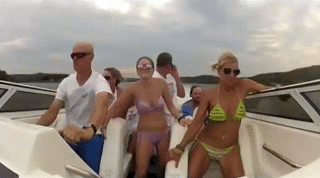Weather is warming up, and that means boaters will be on the water. As you get your boat ready for action, let’s talk safety. There are myths and common practices out there that can ruin a wakesurfing trip quicker than you can say, “Oh S#@T!”
In 2014, the Coast Guard counted 4,064 accidents that involved 610 deaths, 2,678 injuries and approximately $39 million dollars of property damage as a result of boating accidents. See how we’ve BUSTED the myths below.
Myth 1: Lakes don’t have big waves.
Be sure to check the weather before you go out. Lake’s can be just as dangerous as the ocean when conditions go south. Because lakes are shallower than oceans, the waves are steeper and closer together. The closeness of the shorelines reflect the waves from one shoreline to the other which amplify the waves even more so than wind. Be aware when on the lake and give respect to the mighty waves! We consider this myth BUSTED.

Myth 2: Performance boats are the most dangerous.
Feel the need for speed! A common myth in boat safety is that performance (sterndrive-powered) boats are the most dangerous. The 2014 Coast Guard study shows that both outboard boats (1,904) and inboard boats (1,077) were involved in more accidents than sterndrive-powered boats (1,066). Even though they seem more dangerous, the data shows that this myth is BUSTED.

Myth 3: I’m the only one who needs to know how to operate the boat.
We recommend at least one other person on the boat know the ins and outs of your boat and boat safety in general. Assign an assistant skipper on each boat outing and make sure they know what to do, in the event of an accident, to get everyone to shore safely. Myth BUSTED.

Myth 4: I don’t need a boat safety course, I’ve been on a boat before.
This myth might be the most dangerous. Just because someone has been on a boat before does not make them qualified to operate one safely. Both beginners and experienced boaters can benefit from a boat safety course and some states require it. Regardless of the requirement, a safety course is a smart move.
Consider this from the 2014 Coast Guard study, “Where instruction was known, 23% of deaths occurred on boats where the operator hadn't received boating safety instruction. Only 12% percent of deaths occurred on vessels where the operator had received a nationally-approved boating safety education certificate.” Myth BUSTED.

Myth 5: A boating checklist is for OCD people.
A checklist on the boat is always a good idea, not just for the super organized. Check each item before departure. As with any piece of motorized equipment, things fail from time to time and need to be repaired. Having a checklist will ensure issues are not overlooked. Myth BUSTED.

Here are a few items that your checklist may include:
- Weather forecast
- Lifejackets
- Lighting and shapes
- Distress signal
- Fuel and oil
- Tools and spares
- Fire extinguisher
- Ventilation
- Docking and anchoring readiness
- Documentation for your boat
- Emergency locator beacon
- Recreation equipment (wakesurf board!)
Myth 6: It’s ok. We’re only having a few beers.
Statistics show that boating accidents double when alcohol is involved. The 2014 Coast Guard study of recreational boating accidents show that alcohol was the leading known contributor to fatal boat accidents. Save the beers for the patio AFTER wakesurfing. Myth BUSTED.

Myth 7: It’s all good. I have enough life jackets.
It’s not enough to simply have enough life jackets. Make sure every person getting on the boat is fitted properly for a life jacket. You never know when an accident can occur, and each person on board needs to have a life jacket that fits properly to prevent drowning. Myth BUSTED.

Whether you’re out for a quick trip to see the sunset or a whole day of wakesurfing, be sure to put safety first. You won’t regret it and if anything happens, you’ll be prepared! Have fun out there.
